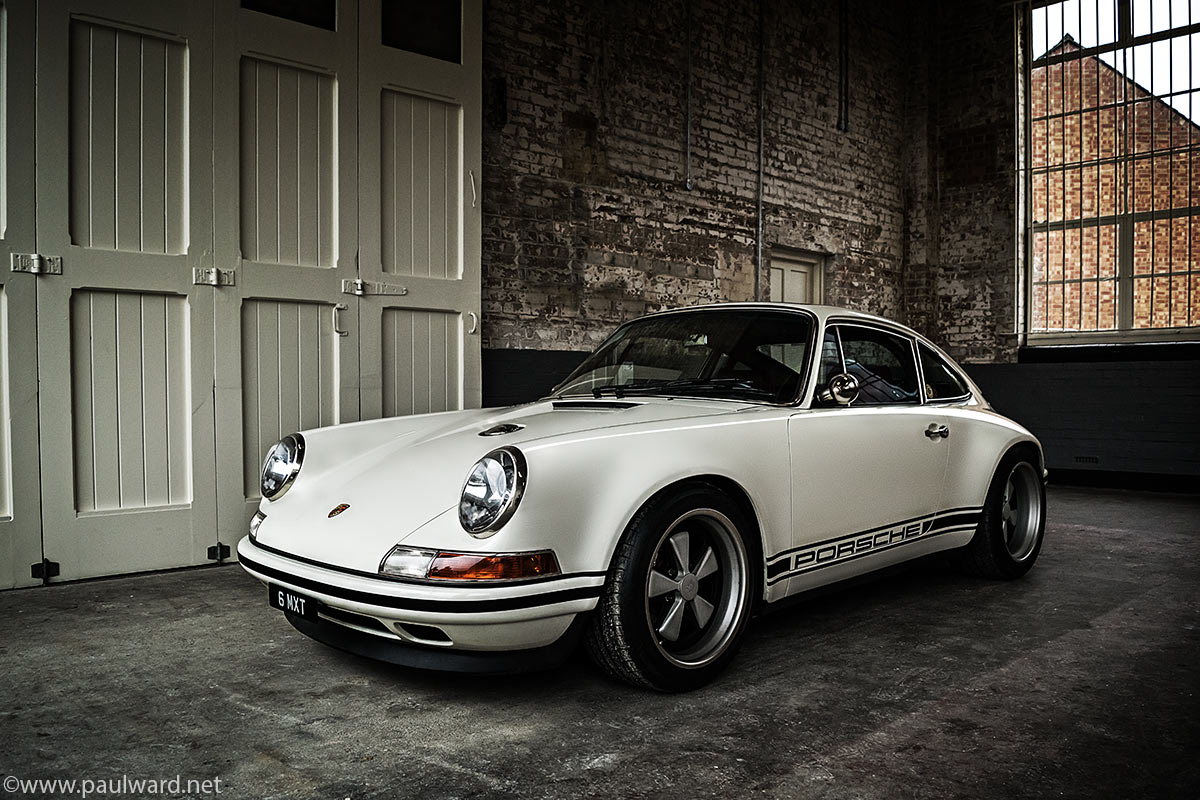Singer Porsche 911 photographed on location at Bicester Heritage by Paul Ward
This image is available as 1 of 100 limited edition prints from Limited100
Singer Vehicle Design
Singer Vehicle Design was started by Rob Dickinson- an ex car designer who then became a rock musician who now stands as one of the worlds foremost distillers of the essence of air cooled Porsche.
Three hundred and ninety thousand dollars for an ordinary 911 is absurd. But this is no ordinary 911.
Singer specializes in the 964-chassis 911, built from 1989 to 1994. The 964 was the first street 911 with coil-sprung suspension, replacing the traditional torsion bars. The 964 chassis also retains Porsche’s classic rear trailing arms, which disappeared in 1995. Along with a rear weight bias, trailing arms help these 911s do wonderful things in corners when you snap your foot off the throttle, and that’s all you really need to know about that.
Singer has 35 employees. With the help of some 150 suppliers, they take customer 964s—”the rougher the better,” Most things are up to the buyer, but everyone gets the same blueprint, to Dickinson’s taste. The shell is stripped and coated. Engineering and manufacturing firm Aria Group fits carbon bodywork, including a roof panel, hood, and fenders. The custom 17-inch wheels look like classic Fuchs alloys filtered through an acid trip. They wear grippy Michelin Pilot Sport PS2s, and like everything else on the car, they are the perfect size.
That’s the ordinary stuff. The rest of the project is a jewel box of history and myth, a sort of greatest-hits Porsche patterned after the car that everyone thinks they remember.
The details are off the reservation. To begin with, a car reimagined by Singer, or Singerized, gets around $12,000 in museum-quality, nickel-plated trim.
Much of it is a reproduction or a slight tweak of a factory piece and the car wears it quietly, like accent stitching on a fine suit. If you order the optional external fuel filler, the vintage-style cast cap set into your carbon hood would shame a Tiffany catalog. Virtually everything that bolts onto the exterior is “betrothed” to a specific shell, hand-fit and unswappable to another vehicle. Much of that comes from shrinking the 964’s tolerances; the bespoke taillights take eight hours to first mate to the car, in part because they meet the fenders with one-millimeter gaps or they don’t leave the shop.
It goes on. Everything in the interior is either built from scratch or reengineered from a factory part. Our test car’s optional track seats—one of three types available—offered wide, 1960s-look headrests paired to a modern, wing-back shell. Turn-signal levers and dash switches are modified or flat out reproduced to look like gems and feel like expensive shotgun parts. Gauges get vintage-look faces with startlingly accurate fonts and proportioning. Basketweave leather on the dash, at perfect right angles, has individual cutouts for the buttons of the Becker radio. The rear seatbacks and package tray, the shift console, the shift lever and knob and carpets and floor mats—it’s all Singer’s, both retro and modern, and gorgeous.
That’s not everything. We don’t have room for everything. Nor do we have a word for this car. The world is full of restomods and backdated 911s. The taste and build quality here make most of them seem like homespun pap.
For perspective, a moment on the door pull: To exit the driver’s seat, you tug a leather strap in the armrest, a nod to Porsche tradition. It replaces the 964’s latch, rides on a plated rub strip, and feels similar, just heftier and quieter. The greatest difference is that the strap moves forward to open the door—the stock latch pops back.
excerpt from roadandtrack
For more info see the Singer website

